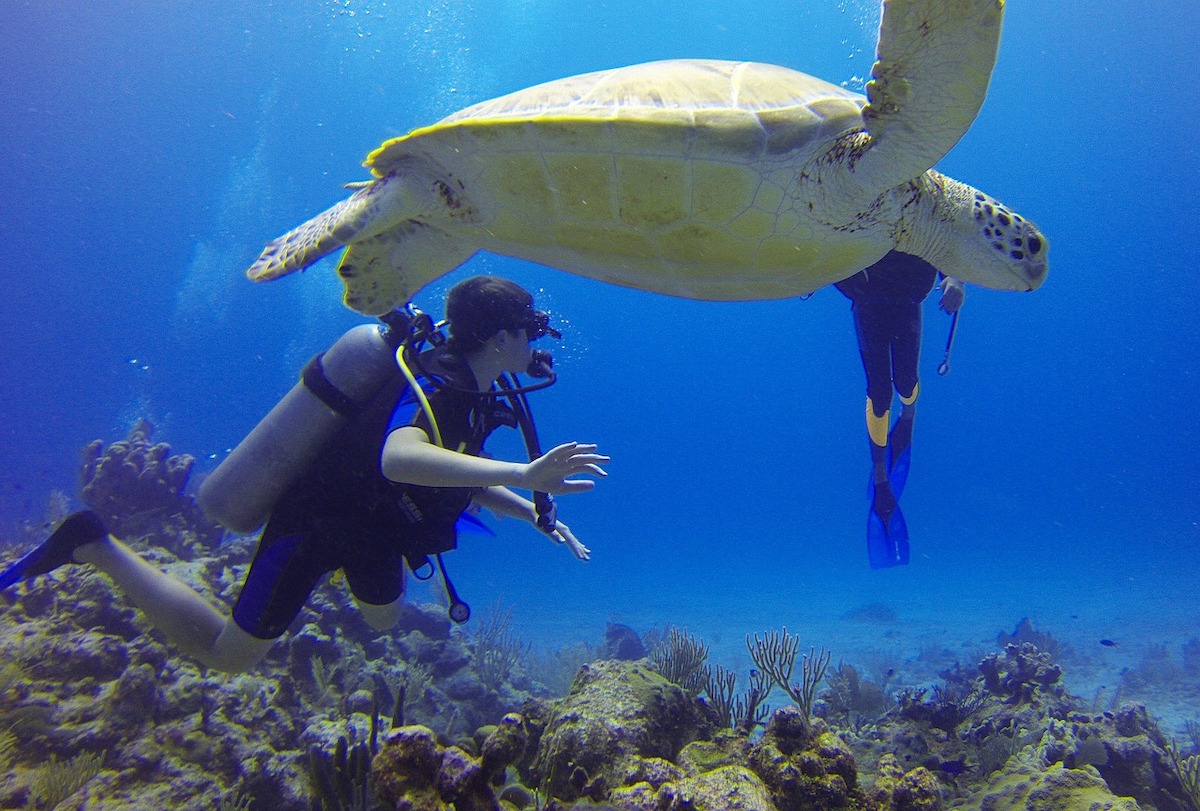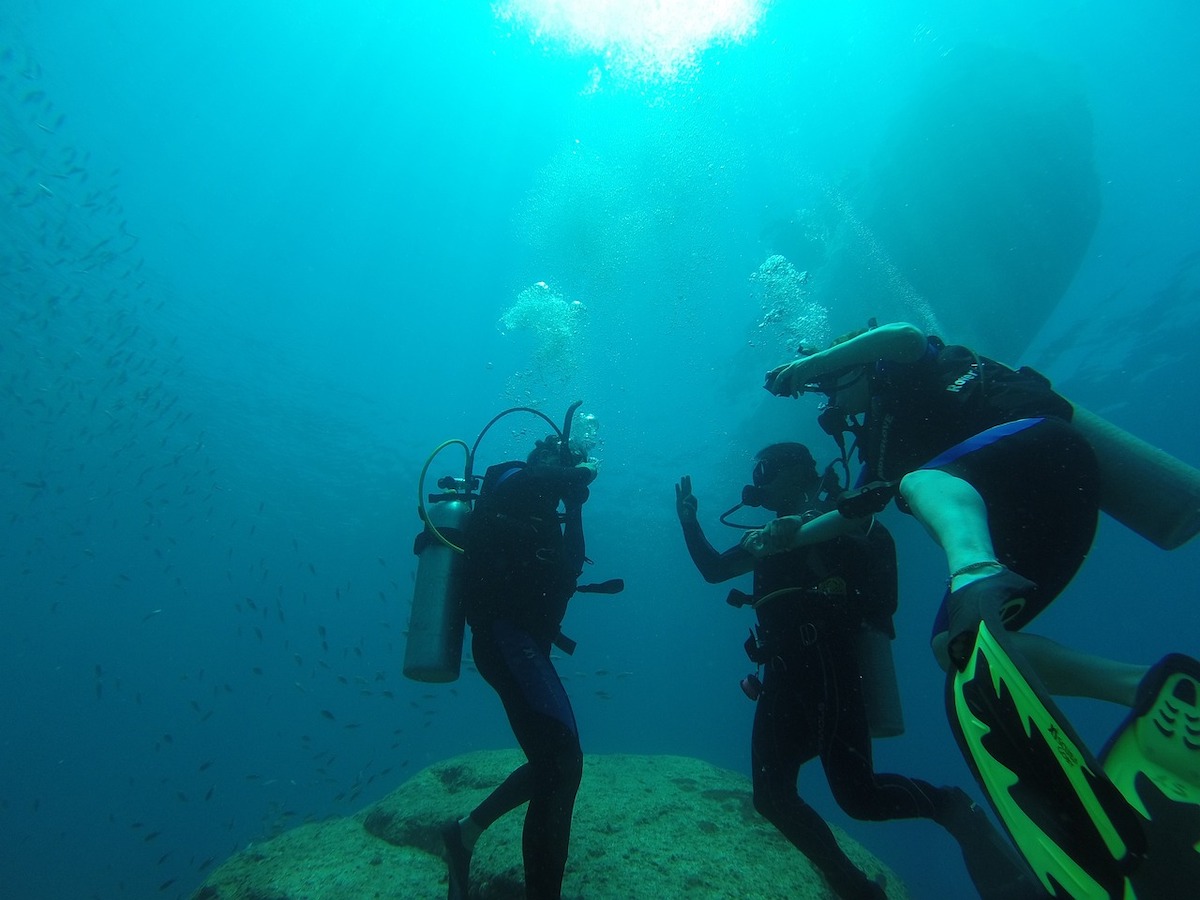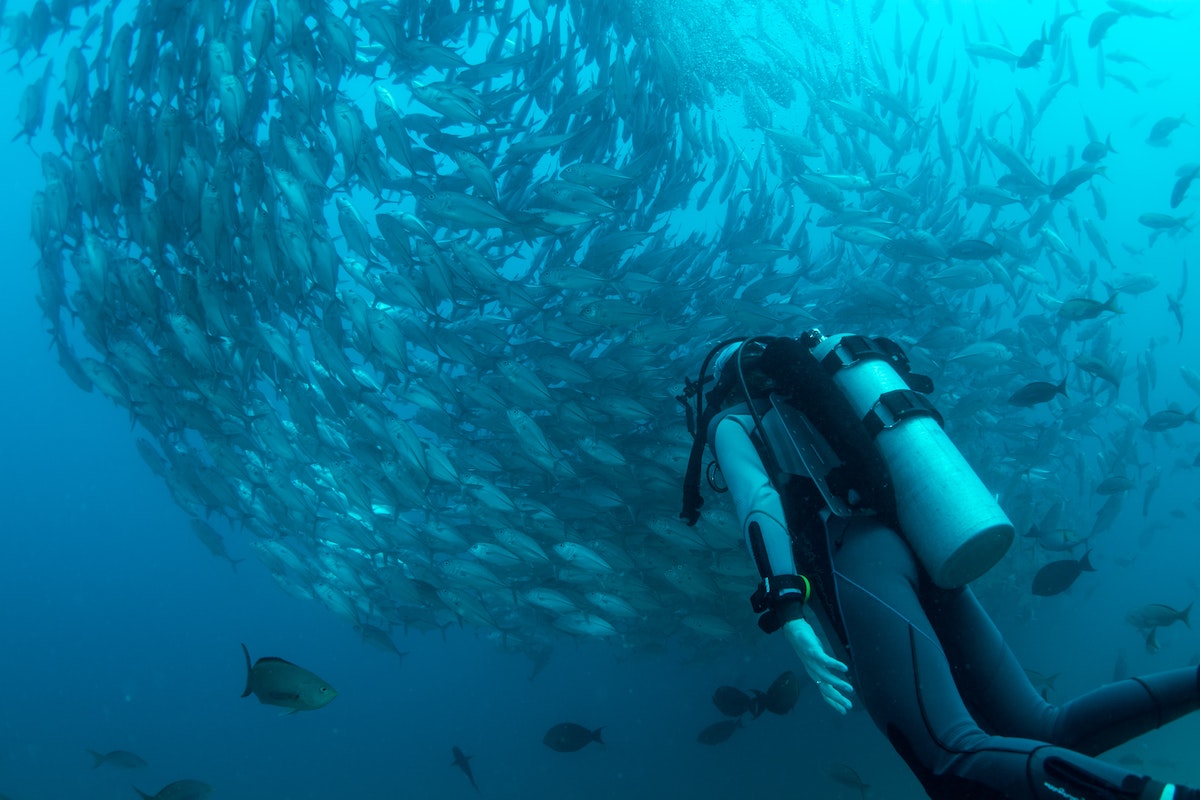By: Sarah Stone
Skip to...
Welcome to the Mayan Riviera! This gorgeous stretch of coastline along the northeastern coast of Mexico’s Yucatan Peninsula extends from Cancun to the Mayan ruins of Tulum.
Beyond the ancient Mayan sites, beach resorts, and must-see towns and cities, the region is fantastic for outdoor adventures like zip-lining, snorkeling, and—of course—scuba diving. Known worldwide for its diversity of marine life, the Mayan Riviera is home to coral reefs, cenotes, and animals you can’t see anywhere else.
With access to the Mesoamerican Barrier Reef—the world’s second-largest coral reef system—and an extensive network of underwater caves and caverns, the region hosts world-class dive sites catering to divers of all skill levels. The tropical climate of the Mayan Riviera ensures year-round scuba opportunities, too!
Let’s go on a trip through the coral reefs, where you’ll see sea turtles, rays, sharks, and a full rainbow of colorful fish species. Travel to dive sites like Playa del Carmen’s Tortuga Reef and Cozumel’s Palancar Reef, or immerse yourself in the beauty of the region’s cenotes. These natural sinkholes, filled with freshwater as well as stalactite and stalagmite formations, can’t be missed—renowned cenote dive sites include Gran Cenote and Dos Ojos in Tulum.
The Mayan Riviera goes beyond coral reefs and cenotes too, with other underwater experiences like diving with migrating bull sharks or exploring the abundant marine life around Puerto Morelos and its connection to the Mesoamerican Barrier Reef.
Ready to go? Let’s dive in!
Best Mayan Riviera Scuba Diving Destinations

Image by jacqueline macou from Pixabay
Playa del Carmen
Playa del Carmen, a lively coastal city that’s home to beaches, nightlife, and tons of shopping and dining options, should be your launchpad for exploring dive sites filled with marine life and gorgeous underwater landscapes. Must-visit dive sites include:
- Tortuga Reef: A vibrant, shallow reef system with sea turtles, rays, and schools of colorful fish, perfect for divers of all abilities
- Barracuda Reef: A thrilling advanced dive site known for its strong currents and larger marine species like barracudas, groupers, and the occasional shark
- Sabalos: A drift dive that takes you among schools of tarpon, jacks, and other pelagic species, best suited for intermediate and advanced divers
Cozumel
The Caribbean island of Cozumel is otherworldly with its bright, clear waters, marine life, and corals. Explore the island’s protected marine park, home to over 30 dive sites catering to all experience levels. Notable sites include:
- Palancar Reef: A vast reef system featuring caves, swim-throughs, and coral structures, where you may encounter turtles, eagle rays, and tropical fish
- Santa Rosa Wall: A wall dive adorned with giant sponges, coral, and tons of marine species, including groupers, nurse sharks, and blacktip sharks
- Columbia Reef: A deep dive site with enormous coral pinnacles, tunnels, and swim-throughs, plus marine life like turtles, moray eels, and large schools of fish
Tulum
The beach town of Tulum, with its ancient Mayan ruins, beaches, and bohemian vibe, offers proximity to the world’s most extensive underground river system—an ideal setting for diving and exploring cenotes. Must-experience dive sites include:
- Gran Cenote: A famous cenote with superb visibility and amazing geological formations, like stalactites and stalagmites, suitable for open water divers and snorkelers
- Dos Ojos: An extensive, interconnected cenote system with two main caverns—the Barbie Line and the Bat Cave—offering an unforgettable diving experience for certified cavern divers
- Casa Cenote: A unique open cenote connected to the ocean, featuring a blend of fresh and saltwater, as well as an eclectic array of marine life, including fish, crustaceans, and even crocodiles
Puerto Morelos
The laid-back fishing village of Puerto Morelos provides access to the Mesoamerican Barrier Reef, the world’s second-largest barrier reef system. Must-see dive sites around Puerto Morelos include:
- La Bocana: A shallow reef dive site with marine life like barracuda, moray eels, and angelfish, perfect for beginner divers and underwater photographers
- Jardines: A colorful coral garden that’s home to a variety of fish, such as parrotfish, butterflyfish, and damselfish, suitable for divers of all skill levels and a great spot for macro photography
- El Tunel: An intermediate to advanced dive site featuring a tunnel-like swim-through, where you’ll encounter lobsters, lionfish, and other marine species while navigating the tunnel and surrounding coral formations
Mayan Riviera Scuba Diving Experiences: Sinkholes, Sharks, and Reefs

Photo by Berthold Grünhagen
Cenote Diving
Cenotes—natural sinkholes created by collapsed limestone bedrock—reveal the hidden groundwater beneath. These one-of-a-kind geological marvels (resulting from the region’s extensive underground river system) are a must-see along the Yucatan Peninsula and the Mayan Riviera.
Revered as sacred by the ancient Maya, cenotes were central to various rituals and ceremonies. Diving into these beautiful formations, you’ll travel through connecting caves and caverns, where you’ll see stalactites, stalagmites, and even fossils. Cenote diving caters to open water divers and those with specialized cave diving certifications.
Bull Shark Diving
From November to March, female bull sharks migrate to the shallow waters near Playa del Carmen to give birth. Seize this unparalleled opportunity to witness these creatures up close, learn about their behavior, and understand their significance in the marine ecosystem.
Bull shark diving draws thrill-seekers from around the globe, which can help the local economy and shark conservation efforts if you visit with respect and adhere to protective guidelines. To ensure a responsible and unforgettable experience:
- Choose a dive operator that prioritizes diver safety and shark welfare
- Follow guidelines such as maintaining a safe distance from the animals, avoiding sudden movements, and refraining from flash photography
- Support operators who avoid baiting or chumming, as these practices disrupt natural shark behavior and can have long-term, negative consequences for the species
Coral Reef Diving
The Mesoamerican Barrier Reef, spanning over 1,000 kilometers from the Yucatan Peninsula’s northern tip down to Honduras, is one of the world’s largest coral reef systems. Home to thousands of marine species, the reef plays a crucial role in regional biodiversity, coastal protection, and fisheries.
The Mayan Riviera is home to several sections of this vibrant ecosystem, making it a great destination for coral reef diving. As you navigate the underwater landscape, you’ll encounter all kinds of fish, turtles, rays, sharks, and dolphins. You’ll also see coral formations like huge brain corals and delicate sea fans.
Diving Seasons in the Mayan Riviera

Photo by Mati Mango
The Mayan Riviera has a tropical climate, with consistently warm temperatures and high humidity throughout the year. Air temperatures average between 75°F (24°C) and 85°F (29°C), while water temperatures typically range from 78°F (26°C) to 82°F (28°C).
The dry season, lasting from November to April, offers slightly cooler temperatures and less rainfall. This period is generally the most popular time for tourists, as the weather conditions are ideal for outdoor activities, including scuba diving.
The rainy season, spanning from May to October, brings higher temperatures, humidity, and more frequent rain showers. Although rain may affect some days, scuba diving remains possible, with visibility often remaining good, especially in the mornings.
Navigating High and Low Tourist Seasons
- High Season: The high tourist season in the Mayan Riviera coincides with the dry season. The region experiences a higher influx of visitors during this time due to favorable weather. Dive centers may be busier, so booking dive trips and accommodations in advance is advisable.
- Low Season: The low tourist season occurs during the rainy season. Despite less predictable weather, this period offers divers some advantages, including lower prices, fewer crowds, and better availability at dive centers and accommodations.
Tailoring Your Trip to Specific Underwater Experiences
- Bull Shark Season: Plan your trip between November and March if you’re keen to dive with bull sharks. This is when female bull sharks migrate to the shallow waters around Playa del Carmen.
- Whale Shark Season: To snorkel or dive with whale sharks, visit between June and September. During this time, these gentle giants migrate to the waters near Isla Mujeres and Isla Holbox to feed on plankton.
- Cenote Diving: Cenote diving can be enjoyed year-round, but the best visibility is often during the dry season. From May to August, the sun’s position creates very cool light effects in some cenotes, enhancing the overall experience.
- Coral Reef Diving: Although coral reef diving is available throughout the year, the dry season generally offers better visibility and more predictable sea conditions. However, the rainy season can still provide enjoyable diving experiences, especially during calmer weather periods.
Choosing the Right Dive Center or Instructor for Your Mayan Riviera Scuba Trip

Image by Sergio Mariscal from Pixabay
Your scuba diving adventure in the Mayan Riviera hinges on choosing the right dive center or instructor. Picking a reputable and certified dive center guarantees top-notch training, guidance, and support during your dives. Plus, it’s essential for your safety, as trustworthy dive centers follow strict safety standards and keep their equipment in the very best shape.
Local Experts and Insights
Seek out dive centers or instructors with extensive local experience. These experts possess in-depth knowledge of dive sites, conditions, and marine life, equipping you with valuable insights and advice to make the most of your diving experience.
Safety First
Choose dive centers with an outstanding safety record, demonstrating their dedication to best practices and customer well-being. Feel free to ask about their safety protocols, emergency plans, and staff training to assess their commitment to safety.
Customer Reviews and Recommendations
Check online reviews and testimonials from previous customers to gauge the dive center’s reputation and customer service. Keep an eye out for consistent positive feedback on the quality of instruction, equipment, and overall experience. Word-of-mouth recommendations from fellow divers can also be valuable when selecting a dive center or instructor.
Certification is Key
Dive centers and instructors in the Mayan Riviera should be affiliated with a recognized scuba diving certification organization, such as PADI, SSI, or NAUI. These organizations ensure dive professionals adhere to standardized training, safety, and operational guidelines.
When selecting a dive center or instructor, confirm they hold valid certification from a reputable certifying body. This affiliation ensures you receive proper training and instruction, paving the way for a safe and thrilling diving experience.
Dive Responsibly: Protect the Underwater Wonders of the Mayan Riviera
The Mayan Riviera is home to a treasure trove of scuba diving experiences, from the colorful coral reefs of the Mesoamerican Barrier Reef to the maze-like underwater caves in the region’s cenotes. Seasonal encounters with marine creatures like bull sharks and whale sharks add to the incredible adventures waiting for you in this tropical paradise.
As you start your Mayan Riviera diving escapades, remember to dive responsibly and sustainably. Choose reputable dive centers, follow best practices, and respect the fragile marine ecosystems to help preserve these unique underwater environments for future generations of adventure-seekers.
Want to read more about scuba and snorkeling around the world? Check out these articles from the Frayed Passport community!
- 6 Best Places to Get Scuba Certification Around the World
- 13 Must-Visit Coral Reefs for Your Next Underwater Adventure
- Dive into the Past: Hunting for Megalodon Teeth in the Gulf Coast
- Snorkeling Iceland’s Silfra Fissure: Thingvellir National Park
- 4 Reasons to See the Great Barrier Reef: An Eco-Adventure
About the Author
 As the editor-in-chief of Frayed Passport, my goal is to help you build a lifestyle that lets you travel the world whenever you want and however long you want, and not worry about where your next paycheck will come from. I've been to 20+ countries and five continents, lived for years as a full-time digital nomad, and have worked completely remotely since 2015. If you would like to share your story with our community, or partner with Frayed Passport, get in touch with me at sarah@frayedpassport.com!
As the editor-in-chief of Frayed Passport, my goal is to help you build a lifestyle that lets you travel the world whenever you want and however long you want, and not worry about where your next paycheck will come from. I've been to 20+ countries and five continents, lived for years as a full-time digital nomad, and have worked completely remotely since 2015. If you would like to share your story with our community, or partner with Frayed Passport, get in touch with me at sarah@frayedpassport.com!
Featured image by Pascal van de Vendel on Unsplash

